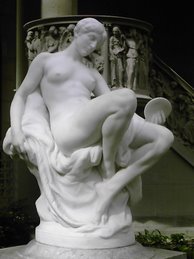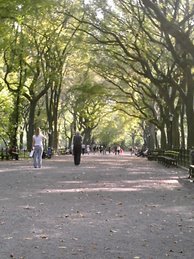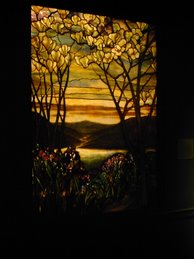Band covers entire classic rock albums
By Joseph Kellard
Wonderous Stories once played the Beatles’ “Sgt. Pepper’s Lonely Hearts Club Band,” the Who’s “Tommy” and Yes’s “Close to the Edge” — all in their entirety. While that’s an unusual set for the five-piece band, performing whole albums is a trademark of Wonderous Stories, whose members further pride themselves on never practicing together or following a set list.
At a show at TJ Farrel’s in Bellmore last Friday, the band played no LPs, yet hinted that they might by opening the show with “Baba O’Riley” and “Bargain,” the first two tracks on “Who’s Next.” By evening’s end, keyboardist Mark Bonder let loose the eerie wind and cathedral-like synthesizer sounds that introduce “Funeral for a Friend/Love Lies Bleeding,” as drummer Ricky Martinez did his best Elton John on lead vocals. Bonder and Martinez are two of the band’s multi-instrumental musicians, along with front man Kenny Forgione and Kevin McCann, who both sing and play guitar and bass, and lead guitarist Tommy Williams.
In between the Who and Elton John songs, the band peppered their sets with a host of Beatles’ tunes, including “Magical Mystery Tour,” “A Day in the Life,” “Taxman,” and “Birthday,” the last at the request of some fans in the crowd celebrating their special day.
“Here’s one you won’t hear everyday,” Forgione said before breaking into “I Am The Walrus,” as Bonder’s keyboard supplied the string section.
While Wonderous Stories’ library features enough familiar tunes, the band never shies away from playing relatively obscure songs. Last Friday, they performed Yes’s most popular song “Roundabout,” when Jon Anderson-like vocalist Laura Press stepped on stage to sing, as well as the lesser known “Heart of the Sunrise” from the same album. “Here goes nothing,” Forgione said before he plunged into that technical number.
While the band is faithful to the recorded versions, sometimes uncannily so, they still take enough liberties with the covers to express their particular styles. The one constant, though, is their spot-on, tight precision, a quality all the more outstanding considering their disdain for rehearsals.
“We’re able to do this because these are all songs we grew up listening to,” said Forgione, who spent his pre-Wonderous Stories’ days performing with McCann.
The duo’s acoustic gigs ranged from well-known Beatles’ tunes to Tears for Fears-like pop songs of the day. But they also injected some personal favorites, such as Peter Gabriel-era Genesis tunes. “And we’d always have some people who would tell us, ‘I can’t believe you’re playing that stuff,’” Forgione recalled.
In 1993, he and McCann formed a trio with Chris Clark, the band’s original keyboardist, who introduced much of the intricate progressive rock, including Yes. After adding a drummer, the quartet played increasingly more sets of this intense, relatively obscure music. The following year, Martinez, the drummer on PBS’s “Sesame Street,” replaced the band’s percussionist, and two years later Williams, the musical director for 1980s pop star Debbie Gibson, completed Wonderous Stories (named and spelled after a Yes song).
In more recent years, Bonder has filled in as Clark has performed on Broadway, most recently in “Wicked.” But when Bonder, Martinez and Williams joined the band, each brought more songs to cover, from Pink Floyd to Steely Dan.
The idea to play whole albums grew out of Forgione’s love of one in particular. “‘Tommy’ affected me from the time I was a kid,” said Forgione, who keeps his long brown hair in a ponytail. “When I heard it, it freaked me out. So if it did that for me, it must have done it for other people, too.”
“All of us said, ‘Wow, this is really fascinating and challenging, let’s try to pull this off,’” Martinez remembered.
The band first tested the waters with “Sgt. Pepper,” as Clark learned to play the difficult parts, like the strings on “She’s Leaving Home.” “People loved it,” Forgione recalled, “because not only are you playing the hits everyone knows, but also the songs that people forget about.”
The band then played “Tommy,” a double-LP, and several other, mostly “concept” albums, including the Beatles’ “Magical Mystery Tour” and “Abbey Road” and Pink Floyd’s “Dark Side of the Moon,” which they once performed at Heckscher Park before some 4,000 fans.
Wonderous Stories draws many fans in their 40s and 50s, but is attracting a sizable younger crowd, including college-age kids, at its gigs at venues like B.B. King Blues Club in Manhattan, Coyote Grill in Island Park, Mulcahy’s in Wantagh, and the Jones Beach boardwalk band shell.
Williams, who grew up in Merrick listening to the Beatles, Cream, Yes and Genesis when disco and punk were the rage, is surprised and heartened when younger fans sing back to them every lyric of every song, even the obscure ones, from any random album they play. He sees this as their yearning for the album era.
“With the advent of downloading, very few people download a whole album — they mostly take a song or two from many different albums,” Williams said. “So the idea of an album as an entity that you listen to, it’s become like an aging bottle of wine. It’s much cooler to get one of those now.”
The band opened its second set on Friday with a medley of vintage numbers, including “Lucky Man” by Emerson, Lake & Palmer, Jethro Tull’s “Aqualung” and Traffic’s “The Low Spark of High Heeled Boys.” Among the last few songs on their impromptu list were the Allman Brothers’ “One Way Out” and “Bodhisattva” by Steely Dan.
“That’s the thing with us,” Forgione said, “you never know what we’re going to play. We don’t even know what we’re going to play.”
To learn more about Wonderous Stories, visit the band’s Web site at www.wonderous-stories.com.
Joseph Kellard is a journalist and columnist living in New York.
Please post comments about this article. For inquiries about Joseph Kellard’s writing services, email him at: Theainet1@optonline.net.
Friday, April 25, 2008
Thursday, April 17, 2008
The Pope on Pedophile Priests
Below is a letter I wrote to the New York Times in response to an article on the pope addressing the issue of pedophile priests in the Catholic Church (“Pope, in U.S., Is ‘Ashamed’ of Pedophile Priests,” by Ian Fisher and Laurie Goodstein, April 16, 2008).
http://tinyurl.com/4ar5rn
This letter is a revision version of an earlier letter I wrote here.
To the Editor:
The pope reportedly has difficulty understanding the actions of his church’s pedophile priests. He would do best to honestly examine certain Christian-Catholic doctrines, specifically their fundamental ideas on man and sex that give rise to pedophiles.
Christianity starts with Original Sin, the doctrine that tells man he is corrupt by nature. Along comes Catholicism to tell him sex is materialistic and thus debased, devoid of spiritual meaning, a “necessary evil” permitted only for procreation among married couples. And so Catholicism deems certain other actions as inherently immoral: pre-marital sex, masturbation, homosexuality and birth control -- because the Bible or its earthly authorities (i.e., the popes) say so.
Moreover, according to Christian doctrine, man is damned not only for his sexual acts, but also for his thoughts, as when he covets his neighbor’s wife. Accordingly, a good Christian must repress sexual fantasy because just that mere thought is morally indistinguishable from a sexual act. Notice, too, that Christianity’s ideals are Jesus, a man without sexuality, and the Virgin Mary, who conceived him without the alleged stigma of sexual intercourse. Priests and nuns embody these ideals in their vows of celibacy.
Meanwhile, Catholics understandably rebel against such a repressive sexual philosophy. Yet some of their religion’s most devote practitioners, priests, essentially revert to another mindless false alternative: sexual hedonism. They who try most to adhere to their faith’s contradictory, anti-man, anti-life ideals must fall short of achieving them and thereby feel unearned guilt and low self-esteem. These consequences can, for some, manifest themselves in an attraction for those they can feel some sense of power over: children.
Ultimately, the pope should understand that Christianity-Catholicism is devoid of, even hostile to, the actual virtues and values that lead to a healthy sex life — independent thought and egoism, and a view of sex as a prideful celebration of one’s rational achievements.
Joseph Kellard
East Meadow, NY
Joseph Kellard is a journalist and columnist living in New York.
Please post comments about this article. For inquiries about Joseph Kellard’s writing services, email him at: Theainet1@optonline.net.
http://tinyurl.com/4ar5rn
This letter is a revision version of an earlier letter I wrote here.
To the Editor:
The pope reportedly has difficulty understanding the actions of his church’s pedophile priests. He would do best to honestly examine certain Christian-Catholic doctrines, specifically their fundamental ideas on man and sex that give rise to pedophiles.
Christianity starts with Original Sin, the doctrine that tells man he is corrupt by nature. Along comes Catholicism to tell him sex is materialistic and thus debased, devoid of spiritual meaning, a “necessary evil” permitted only for procreation among married couples. And so Catholicism deems certain other actions as inherently immoral: pre-marital sex, masturbation, homosexuality and birth control -- because the Bible or its earthly authorities (i.e., the popes) say so.
Moreover, according to Christian doctrine, man is damned not only for his sexual acts, but also for his thoughts, as when he covets his neighbor’s wife. Accordingly, a good Christian must repress sexual fantasy because just that mere thought is morally indistinguishable from a sexual act. Notice, too, that Christianity’s ideals are Jesus, a man without sexuality, and the Virgin Mary, who conceived him without the alleged stigma of sexual intercourse. Priests and nuns embody these ideals in their vows of celibacy.
Meanwhile, Catholics understandably rebel against such a repressive sexual philosophy. Yet some of their religion’s most devote practitioners, priests, essentially revert to another mindless false alternative: sexual hedonism. They who try most to adhere to their faith’s contradictory, anti-man, anti-life ideals must fall short of achieving them and thereby feel unearned guilt and low self-esteem. These consequences can, for some, manifest themselves in an attraction for those they can feel some sense of power over: children.
Ultimately, the pope should understand that Christianity-Catholicism is devoid of, even hostile to, the actual virtues and values that lead to a healthy sex life — independent thought and egoism, and a view of sex as a prideful celebration of one’s rational achievements.
Joseph Kellard
East Meadow, NY
Joseph Kellard is a journalist and columnist living in New York.
Please post comments about this article. For inquiries about Joseph Kellard’s writing services, email him at: Theainet1@optonline.net.
Sunday, April 6, 2008
Book: Greeks & Romans Bearing Gifts
By Joseph Kellard
While browsing through the new books section at my local Barnes & Noble, I came across “Greeks & Romans Bearing Gifts: How the Ancients Inspired the Founding Fathers” by Carl J. Richard.
The book’s liner notes and it chapter headings spoke of individual rights, described America as a republic (not a democracy), and noted the important intellectual influence the ancient Greeks and Romans had on the founding fathers—all of which encouraged me to add this book to my “to read” list. Here is Amazaon.com’s review:
“This lively and engaging book is the only popular work to explore the profound impact of Ancient Greece and Rome on the founding fathers. Recounting the stirring stories the founders encountered in their favorite histories of Greece and Rome, renowned scholar Carl J. Richard explores what they learned from these vivid tales and how they applied these lessons to their own heroic quest to win American independence and establish a durable republic.”
http://tinyurl.com/4pfhel
Mr. Richard’s also published a similar book in 1995 titled: “The Founders and the Classics: Greece, Rome, and the American Enlightenment.”
Again, Amazaon.com has a review:
“While it is well known that the Greek and Latin languages and literatures informed the educations and cultural vocabularies of 18th-century Americans, few studies have fully attempted to describe and explore the formative role of the classics for the leaders of the American Revolution and the framers of the Constitution. Providing abundant examples, historian Richard (Univ. of Southwestern Louisiana) argues compellingly that the classics played a definitive role in the minds of figures such as Jefferson, Adams, Madison, Washington, and many others, providing not only theories of constitutional government, human nature, and virtue but even models for emulation.”
http://tinyurl.com/3h5qve
It appears Mr. Richard’s books may be good sources of intellectual ammunition to be used on the religionists who put so much non-objective emphasis on the founders’ faith and Bible readings as the basis for the government they established.
Joseph Kellard is a journalist and columnist living in New York.
Please post comments about this article. For inquiries about Joseph Kellard’s writing services, email him at: Theainet1@optonline.net.
While browsing through the new books section at my local Barnes & Noble, I came across “Greeks & Romans Bearing Gifts: How the Ancients Inspired the Founding Fathers” by Carl J. Richard.
The book’s liner notes and it chapter headings spoke of individual rights, described America as a republic (not a democracy), and noted the important intellectual influence the ancient Greeks and Romans had on the founding fathers—all of which encouraged me to add this book to my “to read” list. Here is Amazaon.com’s review:
“This lively and engaging book is the only popular work to explore the profound impact of Ancient Greece and Rome on the founding fathers. Recounting the stirring stories the founders encountered in their favorite histories of Greece and Rome, renowned scholar Carl J. Richard explores what they learned from these vivid tales and how they applied these lessons to their own heroic quest to win American independence and establish a durable republic.”
http://tinyurl.com/4pfhel
Mr. Richard’s also published a similar book in 1995 titled: “The Founders and the Classics: Greece, Rome, and the American Enlightenment.”
Again, Amazaon.com has a review:
“While it is well known that the Greek and Latin languages and literatures informed the educations and cultural vocabularies of 18th-century Americans, few studies have fully attempted to describe and explore the formative role of the classics for the leaders of the American Revolution and the framers of the Constitution. Providing abundant examples, historian Richard (Univ. of Southwestern Louisiana) argues compellingly that the classics played a definitive role in the minds of figures such as Jefferson, Adams, Madison, Washington, and many others, providing not only theories of constitutional government, human nature, and virtue but even models for emulation.”
http://tinyurl.com/3h5qve
It appears Mr. Richard’s books may be good sources of intellectual ammunition to be used on the religionists who put so much non-objective emphasis on the founders’ faith and Bible readings as the basis for the government they established.
Joseph Kellard is a journalist and columnist living in New York.
Please post comments about this article. For inquiries about Joseph Kellard’s writing services, email him at: Theainet1@optonline.net.
Friday, April 4, 2008
Whistler's Mother Has Nothing on Them
Long Beach-based artist group for moms shows works in gallery
By Joseph Kellard
A print of Renoir’s "Child in White" on her bedroom wall served as the sister she never had while growing up in Indiana.
"Throughout my life, art has inspired me," said Sueanne Shirzay, the Lido Beach woman who last Sunday opened an exhibit featuring the Long Beach-based Artist Mothers Group at her namesake gallery, located on the second floor above Carpet Craft, at 4410 Austin Blvd. in Island Park.
While Shirzay hopes patrons will find their own personal "Child in White" to inspire them among the AMG’s works adorning her studio walls, she found that joining the group last year inspired her to open the gallery by year’s end.
"It’s really been a constant source of information," Shirzay said about the 13-member group comprised of artists who create in diverse mediums, from paintings to fiber to PhotoShop.
The exhibit, which runs until April 19, also features drawings, jewelry and decorated coffee tables, with paintings ranging in price from prints that go for $45 to originals that climb into the thousand dollar range.
Shirzay, a former advertising and publishing art director and mother of children ages 6, 11 and 13, exhibited her painting "Hydrangeas," featuring the flowers in a suspended glass vase. The painting shared wall space with PhotoShop collages that came from the lens of Denise Bory, a co-founder of AMG. The Lido Beach woman takes detailed digital shots of her subjects, including insects, flower buds and sunsets, and merges these components, usually around a portrait of a child or animal, to evoke a particular theme, such as tropical or seasonal motifs.
"I often change around colors," Bory said about the artistic side of her medium, which she dubs "digistration." "I may start out with something green, like a leaf, and change it to purple.” Bory, whose son is now 8-years-old, was living in Long Beach when she helped establish the Artist Mothers Group in October 2001. Among her cohorts is Lillian Gruber of Long Beach, who then had a toddler daughter and recalled that the idea for a moms-oriented group originated in a breastfeeding group. They found other women there had artistic sides that were inhibited by motherhood. The group would grow to include textilists, sculptors, ceramic craftswomen, and pencil and pastel artists, some of them award winners and others who’d worked for the likes of Hanna-Barbera and Disney.
"We found that it had all been some time since we’d done our art," Gruber remembered, "and that there was nothing here for women with children who could do art."
Some AMG members, along with Bory and Gruber, belonged to the Long Beach Art League, and found that people at that and other groups were simply intolerant of children around for various reasons.
Elizabeth Connolly of Long Beach, a textile designer before she had a child and joined the AMG, said people were mostly concerned that the children would disturb things, whether pieces of art or the calm of the class.
"With the Artist Mothers Group," Connolly said, "we were able to band together and make a place for ourselves, because having our children beside us is important."
At last Sunday’s exhibit, Connolly displayed her coffee table-type polyvinyl bowl, and on a wall hung one of her tapestries, called "Self-Preservation," which featured a canvas covered in layers of objects, including a bouquet of dried-up roses and lavender, a scarf-like fabric and filaments such as earrings and twigs.
Originally, the AMG met weekly at one member’s house, where a babysitter watched their children upstairs while the mothers drew or painted hired models downstairs. The next year, in 2002, the group staged its first show, and it received a grant from the Nassau Council for the Arts, and later was given the opportunity to hold weekly drawing sessions at the Long Beach Community Center, where the group operates today.
Members went on to hold more shows, and in March 2003 received an award from the Nassau Council for the Arts for an exhibit entitled "The Motherhood Experience." This show was held at the Long Beach Library later that year, which made the pages of Newsday, and since then the AMG has exhibited at South Shore galleries. And while the group’s exposure grew, so did its membership that started to include women who had older children.
Paula Gach Moskowitz of Long Beach joined the AMG as a mother of teenagers who needed a place to retreat to paint her portraits and landscapes. But that didn’t mean her children were no longer a distraction.
"When I go to paint, it’s like I leave the world," Moskowitz explained. "But once I had kids, I could never really totally relax like that because your life belongs to them, 24/7, and you’re always worrying about them, and it’s very hard to leave that space of anxiety, concern and vigilance to totally remove yourself."
Moskowitz — whose large painting "Long Beach Sky" is dominated by a dark-blue cloud that dwarfs the beach-goers below — said AMG is important to her because of the empathy they showed for her concerns with family.
"I felt that everyone was serious about their art," she said, "but had the same issue of having to choose between doing your art or taking care of the kids."
Jennifer Turturro of Baldwin got involved with AMG three years ago after her daughter was born, which gave her the opportunity to work at least one time a week on her art when once she had seemingly endless hours. The group also gave her the chance to be around women with the same creative needs.
Besides paints, Turturro works in wool, and one of her pieces on display at the gallery was a basketball-sized hibiscus, whose red, orange and yellow petals were needle and wet felted from a ball of wool. It took about 10 hours to create, but when asked if she did it in one sitting, Turturro laughed and said, "No, over days, because I have toddlers running around the house, and there’s diapers to be changed, meals to be made and toys to be picked up."
For information about the Artist Mothers Group, visit their Web site at artistmothersgroup.com, or contact the Sueanne Shirzay Gallery at (516) 241-5836, by email at shirzaygallery@aol.com or visit the Web site at sueanneshirzaygallery.com.
Joseph Kellard is a journalist and columnist living in New York.
Please post comments about this article. For inquiries about Joseph Kellard’s writing services, email him at: Theainet1@optonline.net.
By Joseph Kellard
A print of Renoir’s "Child in White" on her bedroom wall served as the sister she never had while growing up in Indiana.
"Throughout my life, art has inspired me," said Sueanne Shirzay, the Lido Beach woman who last Sunday opened an exhibit featuring the Long Beach-based Artist Mothers Group at her namesake gallery, located on the second floor above Carpet Craft, at 4410 Austin Blvd. in Island Park.
While Shirzay hopes patrons will find their own personal "Child in White" to inspire them among the AMG’s works adorning her studio walls, she found that joining the group last year inspired her to open the gallery by year’s end.
"It’s really been a constant source of information," Shirzay said about the 13-member group comprised of artists who create in diverse mediums, from paintings to fiber to PhotoShop.
The exhibit, which runs until April 19, also features drawings, jewelry and decorated coffee tables, with paintings ranging in price from prints that go for $45 to originals that climb into the thousand dollar range.
Shirzay, a former advertising and publishing art director and mother of children ages 6, 11 and 13, exhibited her painting "Hydrangeas," featuring the flowers in a suspended glass vase. The painting shared wall space with PhotoShop collages that came from the lens of Denise Bory, a co-founder of AMG. The Lido Beach woman takes detailed digital shots of her subjects, including insects, flower buds and sunsets, and merges these components, usually around a portrait of a child or animal, to evoke a particular theme, such as tropical or seasonal motifs.
"I often change around colors," Bory said about the artistic side of her medium, which she dubs "digistration." "I may start out with something green, like a leaf, and change it to purple.” Bory, whose son is now 8-years-old, was living in Long Beach when she helped establish the Artist Mothers Group in October 2001. Among her cohorts is Lillian Gruber of Long Beach, who then had a toddler daughter and recalled that the idea for a moms-oriented group originated in a breastfeeding group. They found other women there had artistic sides that were inhibited by motherhood. The group would grow to include textilists, sculptors, ceramic craftswomen, and pencil and pastel artists, some of them award winners and others who’d worked for the likes of Hanna-Barbera and Disney.
"We found that it had all been some time since we’d done our art," Gruber remembered, "and that there was nothing here for women with children who could do art."
Some AMG members, along with Bory and Gruber, belonged to the Long Beach Art League, and found that people at that and other groups were simply intolerant of children around for various reasons.
Elizabeth Connolly of Long Beach, a textile designer before she had a child and joined the AMG, said people were mostly concerned that the children would disturb things, whether pieces of art or the calm of the class.
"With the Artist Mothers Group," Connolly said, "we were able to band together and make a place for ourselves, because having our children beside us is important."
At last Sunday’s exhibit, Connolly displayed her coffee table-type polyvinyl bowl, and on a wall hung one of her tapestries, called "Self-Preservation," which featured a canvas covered in layers of objects, including a bouquet of dried-up roses and lavender, a scarf-like fabric and filaments such as earrings and twigs.
Originally, the AMG met weekly at one member’s house, where a babysitter watched their children upstairs while the mothers drew or painted hired models downstairs. The next year, in 2002, the group staged its first show, and it received a grant from the Nassau Council for the Arts, and later was given the opportunity to hold weekly drawing sessions at the Long Beach Community Center, where the group operates today.
Members went on to hold more shows, and in March 2003 received an award from the Nassau Council for the Arts for an exhibit entitled "The Motherhood Experience." This show was held at the Long Beach Library later that year, which made the pages of Newsday, and since then the AMG has exhibited at South Shore galleries. And while the group’s exposure grew, so did its membership that started to include women who had older children.
Paula Gach Moskowitz of Long Beach joined the AMG as a mother of teenagers who needed a place to retreat to paint her portraits and landscapes. But that didn’t mean her children were no longer a distraction.
"When I go to paint, it’s like I leave the world," Moskowitz explained. "But once I had kids, I could never really totally relax like that because your life belongs to them, 24/7, and you’re always worrying about them, and it’s very hard to leave that space of anxiety, concern and vigilance to totally remove yourself."
Moskowitz — whose large painting "Long Beach Sky" is dominated by a dark-blue cloud that dwarfs the beach-goers below — said AMG is important to her because of the empathy they showed for her concerns with family.
"I felt that everyone was serious about their art," she said, "but had the same issue of having to choose between doing your art or taking care of the kids."
Jennifer Turturro of Baldwin got involved with AMG three years ago after her daughter was born, which gave her the opportunity to work at least one time a week on her art when once she had seemingly endless hours. The group also gave her the chance to be around women with the same creative needs.
Besides paints, Turturro works in wool, and one of her pieces on display at the gallery was a basketball-sized hibiscus, whose red, orange and yellow petals were needle and wet felted from a ball of wool. It took about 10 hours to create, but when asked if she did it in one sitting, Turturro laughed and said, "No, over days, because I have toddlers running around the house, and there’s diapers to be changed, meals to be made and toys to be picked up."
For information about the Artist Mothers Group, visit their Web site at artistmothersgroup.com, or contact the Sueanne Shirzay Gallery at (516) 241-5836, by email at shirzaygallery@aol.com or visit the Web site at sueanneshirzaygallery.com.
Joseph Kellard is a journalist and columnist living in New York.
Please post comments about this article. For inquiries about Joseph Kellard’s writing services, email him at: Theainet1@optonline.net.
Subscribe to:
Posts (Atom)

























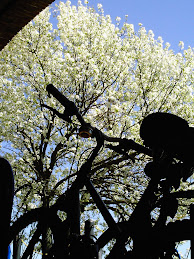



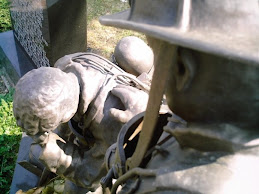

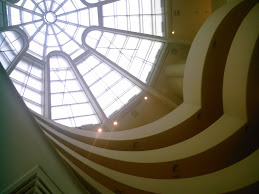+-+June+2009.jpg)


